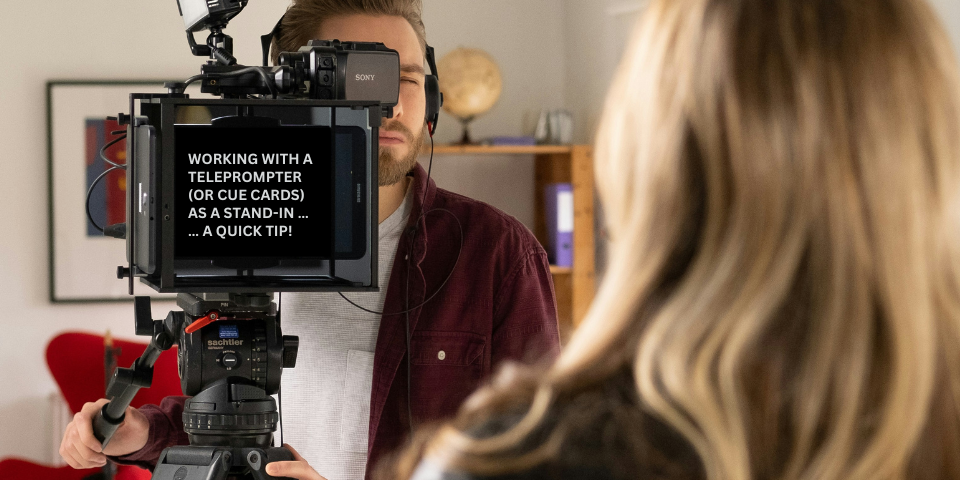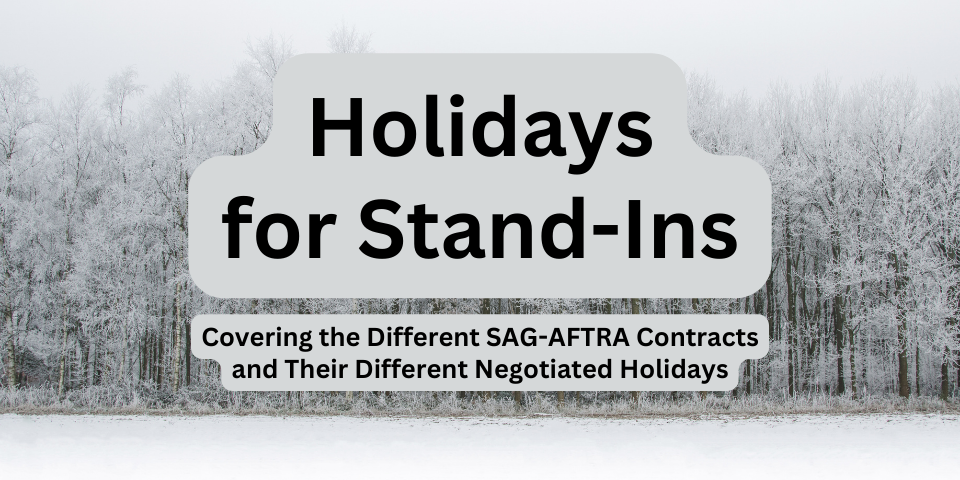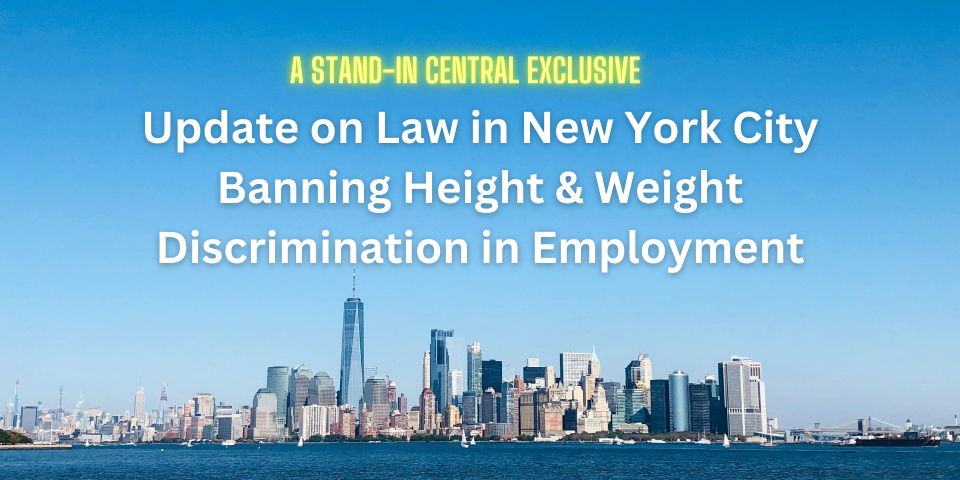There may be times when the nature of your union stand-in job changes. You’ll be on set, and suddenly you’re doing something dangerous. You’re on set, and you’re supposed to be swimming in the scene. You’re standing in and you are asked to do lines on camera as a photo double.
In these types of situations, you may suspect you are deserving of additional money above your rate. If a union rep visits a set, you may explain your situation and the rep may be able to get more compensation for your work that day.
However, all too often these kinds of things go down after the union rep has left, the union is closed, and it’s the middle of the night during the shoot. The question becomes how do you stand up for your interests when you don’t have your union rep there to help you.
This entry aims to give some guidance on what to do when you’re standing in and when your job for the day deserves more compensation.
Your Contracted Rate
As a union stand-in, you have a union contract that governs most situations you find yourself in on set and specifies rates for those situations. For example, if you are hired as a stand-in, you will receive a specific rate determined by the contract. If you are also used as a photo double for that day, you will receive a contracted rate adjustment on top of your contracted stand-in rate. When you work in smoke or when you work under wet conditions, you will also receive a higher rate — a contracted adjustment to your base rate.
But not all situations are easily categorized. In these situations, there may be conventional rates that aren’t outlined in a contract. Then again, there might not be. There may be a conventional rate if you are standing in wearing a bikini, but what’s the conventional rate when you are asked repeatedly to have something fall on your head while standing in?
While there is no right way to negotiate for yourself when you are standing in, there are some basic principles you can follow in getting paid appropriately for work above and beyond what your stand-in job demands.
In short, these general principles are, in order:
- Negotiate at the time of your booking and/or negotiate with an AD on set.
- Ask for a specific dollar amount, perhaps as an adjustment.
- Do the job (if safe and secure to do so).
- Call the union office to report your situation.
Negotiate at Time of Booking
The best time to negotiate for yourself as a stand-in is at the time of booking. That is, when a casting director contacts you for stand-in work, and when something unusual is asked of you for the stand-in job, this is perhaps the best time to negotiate your compensation.
When you ask for additional compensation, the casting director may then call production to clear the compensation. If accepted, you and production should have a clear understanding of your compensation when you show up to work. Your compensation may be marked on the skins for added assurance. (The skins is the list of background actors and stand-ins the background PA has when you check in.)
Of course, use caution in negotiating for yourself at the time of booking. While you should be fairly compensated for doing stand-in work above and beyond normal duties, requesting more compensation may lead casting or production to pass on you.
Adjustments vs. Bumps
In negotiating for yourself as a stand-in, it is important to note the difference between adjustments and bumps.
An adjustment is additional money added to your base rate. If as a stand-in you are making $169 for 8 hours ($21.13/hour), this is your base rate. An adjustment of $10 means you would be making $179 for 8 hours ($22.38/hour) — and your overtime would be calculated off that base rate.
A bump is additional money that is not added to your base rate. If as a stand-in you are making $169 for 8 hours, and if you ask for a $50 bump, you would be making $169 for 8 hours ($21.13/hour) plus a $50 bump. Your overtime would be calculated off of $169 — not off of $219 ($169 + $50).
When negotiating, it may be strategically in your interest to ask for an adjustment to your rate rather than a bump. If you know it will be a long day, an adjustment of magnitude could prove more lucrative for you than a bump. For example, if you ask for a $50 adjustment to your $169 stand-in rate, you could be making $219 for 8 hours ($27.38/hour), and overtime will be figured off of that base rate.
If instead you asked for a $50 bump, you’ll work at $21.13/hour and have $50 added on after. In that scenario, your overtime will be lower than if you worked for $219 for 8 hours ($27.38/hour), so in this case your check will be lower when you ask for a bump than when you ask for an adjustment.
Granted, if you know it’s going to be a short day, it might behoove you to ask for a $250 bump. The thinking would be that you won’t qualify for overtime, so whether the $250 is a bump or an adjustment means almost nothing. But given that the length of a shoot day is usually unknown, it is usually in your best interests to ask for an adjustment over a bump and see how production responds.
Some productions may not be careful in negotiating and may inadvertently agree to an adjustment when it would be more in their interest to agree to a bump. For this reason, it is good to try to open with an adjustment rather than a bump. However, it is perfectly fine to open instead with a request for a bump.
Ben’s Tip!
Be sure to ask for an amount! When you are negotiating, ask for a specific amount of money that you find would make you (very) happy. On the flipside. avoid asking for an adjustment or a bump without saying how much you want. So, rather than saying, “Could I get an adjustment for standing in on a cliffside?,” instead ask, “Could I get a $100 adjustment for standing in on a cliffside?”
The reasoning is that it’s harder to negotiate up than down. If you don’t say how much you want and production lowballs you, it will be hard for you to make a case to get something higher. If you ask for an amount that would make you (very) happy, you have room to negotiate so that you can end up (very) happy.
Negotiate on Set
Say that you reach set and your stand-in job morphs into something you’re not comfortable doing without more compensation. Once you find out you are being requested to do something you believe you deserve more money for, you can negotiate on set.
The appropriate people with whom to negotiate are the ADs. Perhaps your best bet is with the 2nd 2nd AD. If not the 2nd 2nd AD, then the 2nd AD may be the next best option. Either of them will be most appropriate people to talk to on set when figuring out your compensation.
Again, make sure you are clear on what you want. Do you want an adjustment, or a bump? Or, do you find that what you are doing is deserving of a principal or stunt contract? Get the ball rolling as soon as it is appropriate when your stand-in job exceeds your expectations. If you have trouble pulling the 2nd 2nd AD aside, ask the background PA to get the 2nd 2nd AD in touch with you.
Do the Job
Unless perhaps your safety or security is threatened, in general, do the stand-in job asked of you whether production has or has not agreed to the additional compensation for you.
For example, if you are asked to stand in, then photo double and do lines on camera, go through with it (insofar as you are not performing a dangerous stunt, exposing yourself in a way you refuse to, etc.). More than likely you are in a position to receive more compensation whether production agrees to it or not.
Should a union rep show up after you do the excessive work, talk to the union rep about your situation and the balls may be set in motion for receiving additional compensation. If no union rep shows, the next day call the union office.
Call the Union Office
If production does not agree to additional compensation for you for a stand-in job for which you feel you deserve it, call the union office the day after the job and explain your situation. In fact, even if you negotiate additional compensation for yourself for a stand-in job, call the union office the next day anyway to explain the situation. There is a chance you’ll be entitled to even more compensation, especially if you agreed to lowballed compensation or when you agreed to do work that a principal actor or stunt person would typically do.
SAG-AFTRA National Contact Information:
http://www.sagaftra.org/sag-aftra-national-contact-information
SAG-AFTRA Local Contact Information:
http://www.sagaftra.org/locals
Final Thoughts
Many stand-ins are unfamiliar with how to negotiate on set, and the principles above should help give an outline for approaching the task. There may be other ways to negotiate as well. Whatever the case, receiving fair and appropriate compensation for your work will make you extremely happy, so it is ideal to pursue it when you feel you aren’t getting it!
Do you have other tips for negotiating for a higher rate when working as a stand-in? Do you have your own experiences negotiating? If so, share below!






Leave A Comment